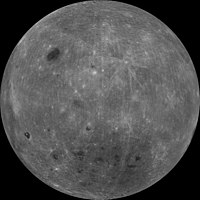Distribution of Craters on the Moon
-
The Code
- 2+2=5
- Posts: 913
- Joined: Sat Mar 07, 2009 6:39 pm
- AKA: Swainy
- Location: The Earth, The Milky Way, Great Britain
Distribution of Craters on the Moon
Is it possible that the Earth protected the Face of the Moon from the meteor bombardment long ago. Are there more Craters on the dark side of the Moon?
Mark
Mark
Always trying to find the answers
Re: Distribution of Craters on the Moon
There is no 'Dark Side of the Moon", except for Pink Floyd's album, only near side and far side. I would expect the far side to be more cratered, as the near side was partially shielded by the Earth.
- Chris Peterson
- Abominable Snowman
- Posts: 18412
- Joined: Wed Jan 31, 2007 11:13 pm
- Location: Guffey, Colorado, USA
- Contact:
Re: Distribution of Craters on the Moon
Most of the cratering on the Moon occurred during the Late Heavy Bombardment about 4 billion years ago. That was before the Moon became tidally locked, so it wasn't keeping any one face directed towards the Earth. Since it became tidally locked, its distance has been such that the Earth was never larger in its sky than a couple of degrees. You could imagine that the part of the Moon directly under this small "shield" might get slightly less meteoroid activity, but the Earth also acts as a gravitational lens, focusing bodies slightly towards the Moon. So any effect by the Earth, either enhancing or reducing lunar impacts, is probably too small to detect.mark swain wrote:Is it possible that the Earth protected the Face of the Moon from the meteor bombardment long ago. Are there more Craters on the dark side of the Moon?
Cratering is similar on the near and far sides of the Moon. The total number of craters is higher on the far side, but that's because that side was never flooded by the basalt plains we see. The cratering rate is about the same. Actually, the cratering rate is slightly higher in the western hemisphere, since that is the leading edge in the Moon's orbit around the Earth, and it therefore accumulates slightly more debris. The difference is subtle, however.
Chris
*****************************************
Chris L Peterson
Cloudbait Observatory
https://www.cloudbait.com
*****************************************
Chris L Peterson
Cloudbait Observatory
https://www.cloudbait.com
- neufer
- Vacationer at Tralfamadore
- Posts: 18805
- Joined: Mon Jan 21, 2008 1:57 pm
- Location: Alexandria, Virginia
Re: Distribution of Craters on the Moon
Don't you mean the eastern hemisphere, since that is the leading edge in the Moon's orbit around the EarthChris Peterson wrote:Cratering is similar on the near and far sides of the Moon. The total number of craters is higher on the far side, but that's because that side was never flooded by the basalt plains we see. The cratering rate is about the same. Actually, the cratering rate is slightly higher in the western hemisphere, since that is the leading edge in the Moon's orbit around the Earth, and it therefore accumulates slightly more debris. The difference is subtle, however.
Art Neuendorffer
- Chris Peterson
- Abominable Snowman
- Posts: 18412
- Joined: Wed Jan 31, 2007 11:13 pm
- Location: Guffey, Colorado, USA
- Contact:
Re: Distribution of Craters on the Moon
When you look at the Moon from the Earth, the western hemisphere is to the east, and the eastern hemisphere is to the west. This convention means that from the Moon, the Sun rises in the east and sets in the west. It also means that the lunar western hemisphere is the leading side in the Moon's orbit around the Earth.neufer wrote:Don't you mean the eastern hemisphere, since that is the leading edge in the Moon's orbit around the Earth?
Chris
*****************************************
Chris L Peterson
Cloudbait Observatory
https://www.cloudbait.com
*****************************************
Chris L Peterson
Cloudbait Observatory
https://www.cloudbait.com
-
joetommasi@yahoo.com
Re: Distribution of Craters on the Moon
Is there an age difference between the lunar seas and the highlands? And how do we know this age difference?
- neufer
- Vacationer at Tralfamadore
- Posts: 18805
- Joined: Mon Jan 21, 2008 1:57 pm
- Location: Alexandria, Virginia
Re: Distribution of Craters on the Moon
The highlands are more cratered than the seas; hence, they must be older.joetommasi@yahoo.com wrote: ↑Sun Dec 09, 2018 8:59 pm
Is there an age difference between the lunar seas and the highlands? And how do we know this age difference?
Art Neuendorffer


